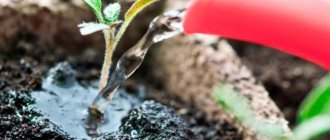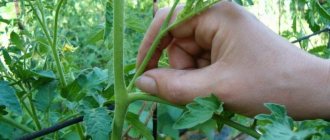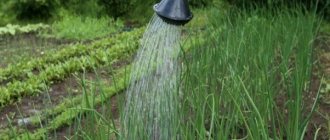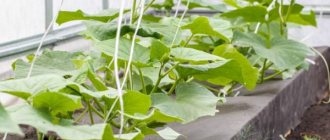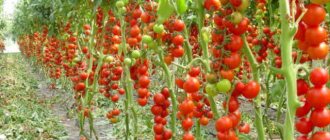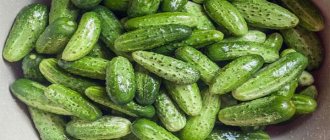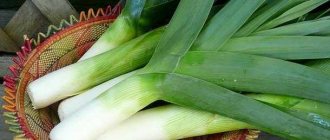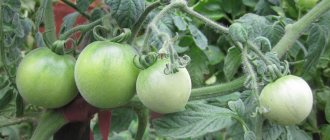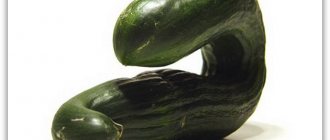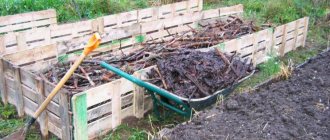Agricultural technology for zucchini in open ground
Zucchini belongs to the melon crops and is a type of pumpkin. Agrotechnical techniques for caring for them in open ground include weeding, loosening rows, watering and fertilizing. The plant has a powerful root system. The central root goes to a depth of about 1 m, and long lateral shoots are located in the surface layer of soil. This allows the plant to perfectly absorb liquid and replenish its reserves for a long time.
Zucchini is resistant to drought, but the abundance of the harvest depends on how watering is organized in the open ground. Suffice it to remember that the fruits of the crop consist of 94% water and the answer to the question of whether zucchini likes water becomes obvious. But everything should be in moderation. Excess moisture causes pumpkins to rot and reduces their sugar content.
What kind of water should I use?
The easiest and fastest way to irrigate a garden is to water with a hose. If water for irrigation is taken directly from a well or water supply, then this is not suitable for zucchini. The culture needs warm moisture with a temperature of at least +20°C. Is it possible to water pumpkin plants with cold water? This should not be done, cold moisture causes shock in the plant, and the capillaries of the roots shrink. Water is not absorbed, the crop suffers from drought.
Another negative factor of cold watering is the development of fungal spores. A weakened bush cannot resist infection, and downy mildew or downy mildew begins. How to properly organize irrigation with warm water? All you have to do is place the barrel and keep it full. During the day, the liquid is heated by the sun.
Advice. Use rainwater for irrigation; it is collected under the drain during rainfall. The absence of chlorine has a beneficial effect on the quantity and quality of pumpkins.
Irrigation methods
Before choosing one or another irrigation method, you first need to decide on the area of the site, and then make sure that this method will actually provide timely watering according to the type of plant.
All irrigation methods are very easy to use and do not require any special equipment. Absolutely all units can be made independently from available materials. Such work will not take much time, which is important. You just need to arm yourself with desire and patience in order to grow a truly rich harvest. So, let's look at the 4 most common methods of irrigating zucchini in summer cottages.
Method 1
Using dosed watering with plastic bottles. You need to choose a capacious container and cut off the bottom, and make several holes (6-7 pieces) on the lid with an awl so that water does not flow out of them, but drips. The irrigation unit is ready for use. Next, at a distance of 0.2 meters from the plant, you need to dig a hole 0.15 meters deep and place a bottle filled with water in it at an angle of 45 degrees. This way, the zucchini will be watered directly under the root. And water consumption will be economical.
Method 2
To carry out this type of watering, you will also need plastic bottles with a cut bottom. But they need to be hung over the plant, and the lid should just be unscrewed a little, without making holes.
This method has a small drawback - the risk of washing out the soil, so in the place where the water will drip, it is enough to put pieces of organic waste or small pieces of foam rubber.
Method 3
Many gardeners call it jet. You will need a hose that has many small holes in it. The hose is dug into the ground and connected to the water supply system. If the water supply is correctly adjusted, there will be no moisture on the surface, and only the root system of the vegetable will be watered.
Method 4
Its name is “wick”. It is the most economical compared to the others. The essence of the method is to place various containers throughout the entire area of the site. This can be any container: buckets, cans, bowls, bottles, disposable glasses. Then take a tourniquet, which is easy to make yourself (just twist some fabric tightly), one end of which is lowered into a container of water, and the other is dug along the bed (to a depth of about 0.15 meters). Thus, the fabric will get wet, and the moisture will begin to go into the soil.
Watering seedlings after planting in the ground
After planting in open ground, seedlings begin to be watered after 3-4 days. At this point, the seedling is rooting. The water should be warm. For irrigation it is better to use a watering can. 2-3 liters of water are poured under the seedlings. The frequency depends on climatic factors, usually 1-2 times a week is enough. When moistening, pay attention to the condition of the soil cover. If the bushes are not hilled, water erodes the outer layer and exposes the roots. It is recommended to backfill with brought soil or peat.
Experienced farmers use mulching. The beds with young zucchini are covered with straw or peat with humus to a depth of 5-7 cm. Thanks to the mulch, a crust does not form after watering, and there is no need for loosening. The soil structure improves, air flows easily to the roots.
Advice. In hot weather, watering and mulching should be combined. A layer of mulch delays moisture evaporation and prevents roots from overheating.
Things to remember
Experienced farmers prepare the place for zucchini in advance, fertilizing the soil before planting the crop. Autumn or spring work is accompanied by soil enrichment. If you did not have time to pre-treat the area, then when planting, fertilizer is poured into each hole. Remember: liquid fertilizers are added to the soil after watering.
Chemicals burn the tender roots of plants, so death or developmental delays are possible.
To grow a healthy, strong plant that will delight you with delicious fruits, you need to know the requirements of a specific crop. Our recommendations will help you easily get a bountiful harvest of zucchini grown in open ground. Regular watering and care will not be difficult.
Irrigation of bushes during flowering and fruiting
The period of flowering and fruit formation requires a lot of moisture and nutrients. How many times should I water the crop in open ground after the buds appear? Irrigation schedule is every 3-4 days. It is not the frequency that is important, but the volume of hydration. At the beginning of the growing season, up to 5 liters of liquid are consumed per plant; by the time of fruiting, the rate is doubled to 10 liters. Moisture should not wet the top layer of soil, but penetrate deep into the main root. Insufficient irrigation results in various problems:
- The bushes are dominated by male flowers - barren flowers that do not bear fruit.
- The development of the plant slows down, pumpkins do not increase in size, the ovary falls off, and the juiciness of the pulp decreases.
- The leaves dry out and curl, the stem becomes stiff.
The fruiting period of the crop occurs in July and August. For many regions they are characterized by high temperatures and low precipitation. Gardeners need to take good care of their vegetables. The soil moisture level at the beginning of vegetable ripening should not fall below 80%.
Advice. To prevent fruits from rotting in wet soil, experienced gardeners place film or planks under them.
Basic rules of watering:
- Irrigation is performed in the evening, with diffused lighting. Do not pour water during the day; drops that fall on the leaves and stem cause burns. If the crop is moistened in the morning, then no later than 8-9 hours. The liquid should be well absorbed into the ground and not evaporate under the sun.
- In hot weather, proper watering helps the plant survive unfavorable conditions. Moist soil under the cover of leaves provides cooler temperatures.
- The stream of water is directed under the root; the above-ground parts of the plant do not tolerate moisture well. When using a hose, put on a nozzle with a sprayer. Small drops penetrate the soil better and have time to heat up a little.
- During the period of fruit formation, moisture should penetrate to a depth of 35-40 cm.
- The irrigation regime must take into account the characteristics of the soil. Sandy soils require frequent watering; clay soil retains moisture better, so zucchini is watered less often.
Information. Farmers combine irrigation with fertilizing. For better absorption of nutrients (organic or mineral elements), a moist environment is required.
Is it possible to water with cold water?
Watering should be done early in the morning and the water should be warm. By no means cold. It is better to warm the water temperature to 20 degrees Celsius so that the growth of the vegetable is more intense. Water for irrigation is prepared in advance. To do this, it will be enough to take the containers with liquid to an area well warmed by the sun. However, observe moderation - keeping water in the scorching sun all day is also not necessary. Like cold, hot water also negatively affects the growth of zucchini; it slows down the growth and development of the bush.
Why can't you water zucchini with cold water? Because for this vegetable, cold water can cause a “shock reaction”. That is, in hot weather, the difference in temperature between the environment and the water will lead to the fact that the peripheral roots will begin to die, and the main ones, due to the illusion of watering, will not fully absorb the required amount of water. Because of this, the growth of the plant will slow down, or even stop completely.
Watering methods
The drip system is a common way to organize proper watering after planting seeds or seedlings in the ground. There are several options for irrigation devices.
Drip tapes
The universal system includes a spacious water tank, pipelines and drip tapes. The hoses are laid out along the beds, and there is a hole near each plant. This option allows you to save water.
Use of plastic bottles
Dosed watering is organized using 5-liter plastic bottles. Method 1:
- cut off the bottom of the bottle;
- make 5-6 holes with a diameter of 2-3 mm in the lid;
- bury the neck near the zucchini bush to a depth of 15 cm;
- fill the bottle with warm water.
- make 4 holes at a distance of 2 cm from the bottom of the container, one on each side;
- fill the bottle with warm water and close the lid;
- bury the container near the bush, leaving 15-20 cm on the surface.
Water is added to the container as it is consumed. The advantage of the method is the direct direction of moisture to the roots. The surface remains dry, the fruits are not in danger of rotting. To make it convenient to monitor the filling of the container, it is not buried, but hung near the bush. The method requires a little more construction costs. It is necessary to install a support and secure the inverted bottle on it. The disadvantage of this method is that the soil is washed away by drops; mulching helps prevent erosion.
The drip irrigation system allows moisture to be distributed evenly, the soil is not washed away, and a crust does not form. Feeding of plants is organized through it. Dissolved fertilizers are poured into bottles or a common tank for irrigation.
Industrial irrigation
Subsoil
- financial opportunities;
- relief of the site;
- availability of water resources;
- irrigation purpose.
Subsoil
The essence of the method is as follows:
- metal or polymer pipes are buried between rows to a depth of 25-40 cm;
- holes are first made in them;
- water is released into the system.
In this way, moisture reaches the zucchini. The leaves remain dry and no crust forms on the surface. The disadvantages of the method include the difficulty of supplying liquid.
Sprinkling
The sprinkling method is used on an industrial scale
Watering plants in this way is rational for large farms, because it requires expensive and complex equipment. The essence of the method:
- water is supplied through the pipeline from the pump under high pressure;
- Depending on the type of sprinkling, drops form on the nozzles or the liquid disperses in the form of fog.
The method is characterized by low water consumption and uniform watering. But we must take into account that most of it evaporates without fulfilling its purpose. It is necessary to moisten the soil by sprinkling many times.
Gravity
The method has 2 subtypes:
- furrow - water is supplied along the rows;
- estuary - complete flooding of the area.
The method is characterized by low cost and high productivity. But water is supplied to the plants unevenly, resulting in large overuse. Not all farmers choose estuary watering of zucchini when caring for their crops due to the fact that the substrate becomes too compacted and a crust forms on the surface.
Drip
Water flows through it at a programmed speed. Enters the root zone. The equipment is expensive. It is even used on slopes. The method involves using clean water, otherwise the droppers will clog.
The method is chosen based on the farmer’s capabilities. The terrain of the field and access to water resources are also taken into account.
Subsoil
Lay metal or polymer pipes. They must meet the following requirements:
- walk parallel to the rows;
- placed at a depth of 25-40 cm;
- have holes.
Water is connected from the main pipeline. With this method of watering, a crust does not form, but it is difficult to regulate the flow of liquid.
Sprinkling
Water is supplied from the sediment through a pipeline under a pressure of 2-3 atm. Large droplets form on the spray nozzles. This method is often used when water disperses in the form of fog. The consumption then turns out to be low - 200-600 ml of liquid per 1 sq. m, but in this case watering the zucchini will have to be done many times.
The advantages of the method include:
- uniformity of watering;
- saving water;
- high performance.
Disadvantages include evaporation of moisture from the ground. The equipment is expensive, so not every company can install it.
Gravity
- furrow - water is supplied to the zucchini along the furrows. The method is cheap. The liquid consumption is high, but it is supplied unevenly to different areas;
- estuary - the field is flooded. After this, the earth becomes compacted and a crust forms. The method is characterized by excessive water consumption, but it does not require large other costs.
Drip
Polymer drip tape is installed between planting rows. Liquid is supplied at the programmed rate. It goes to the roots of the plant.
This is one of the most modern and high-tech methods. It can even be used on slopes. To prevent the droppers from clogging, the water must be perfectly clean with low mineralization. The equipment is expensive.
Features of watering
Most gardeners do not even think about how moisture affects the growth of squash crops. But if you do not regularly water zucchini when growing in the garden, this will affect the yield, as well as the health of the entire fruitful bush. It is for this reason that it is worth knowing all the features of watering the squash crop, namely:
- zucchini should not be watered with cold water; the lowest water temperature that is acceptable for watering should not be below +10C;
- this fruit variety loves to be hydrated with settled water, which is also heated by the sun’s rays;
- If you are watering a squash bed in cloudy weather, don’t be lazy and heat the water so that it is a little hot.
If you monitor the water temperature, you can protect your squash bed from the following defects:
- fusarium;
- powdery mildew;
- various rots;
- anthracnose;
- brown spot.
It is worth emphasizing that, unlike cucumbers, zucchini does not require frequent watering. It is important for them to irrigate generously, but less frequently. In this case, the soil must dry completely between procedures. As for the frequency of watering, in this case everything depends on weather conditions.
If it’s a dry summer outside, you need to moisturize every week. Well, if rain, even occasionally, moistens the garden, watering is carried out only when the soil under the zucchini has dried by 3 cm. Such watering recommendations are suitable for adult shrubs.
Watering during flowering
The beginning of the zucchini flowering period coincides with the active growth phase. The air temperature usually does not drop below +15-20 degrees. Abundant flowering of plants and the appearance of ovaries in the first 3-5 days do not require changing the watering regime. It is enough to pour 10 liters under each bush. When the zucchini begins to ripen and reaches a quality sufficient for consumption, it is recommended to increase the volume of water to 15-20 liters per plant, and be sure to monitor the temperature - if it rises above +30, the frequency of watering must be increased.
How to water zucchini correctly
In general, from the beginning of zucchini growth until harvest, watering is carried out according to a certain schedule. Depending on the period of its growth, moisture should be as follows:
- For young shoots, the watering schedule should be once every three days. This frequency of watering must be strictly observed, since a sharp transition from moisture to dryness can lead to the death of a fragile plant.
- During the flowering period, moistening should be carried out twice a week, while strictly monitoring the condition of the soil; it should not be allowed to dry out. But at the same time, excessive moisture will be detrimental to the squash bush. Excess moisture will lead to root rotting, and the fruit itself will lose its keeping quality.
- If it is very hot outside, then regardless of the period of formation of the squash crop, watering must be done once every three days. Otherwise, you risk losing your harvest due to drought.
Another important question is how to water zucchini and how much water should be supplied to each bush. As described above, irrigation should be plentiful. So, each bush should be moistened to a depth of 60 cm.
Before the formation of the ovary in the squash bed, 10 liters of warm water are poured under each bush. Well, when the buds have faded and small zucchini become visible, it is necessary to increase the amount of water to 15 liters for each bush. When watering each shrub, do not forget that allowing water to stagnate at the root is very dangerous for this crop. Therefore, carefully monitor the hydration process.
It is recommended to water zucchini in open ground along with fertilizing.
To reap a generous harvest, experienced gardeners recommend adding organic matter under the bush along with water once every two weeks. The fact is that, unlike other garden crops, zucchini must be fertilized with organic matter during the growing season. It is especially important not to forget to apply fertilizer at the time when the squash crop begins to bloom.
As soon as the fruits begin to ripen, it is necessary to spray the leaves. The fact is that due to a lack of nitrogen, the squash tips begin to become slightly deformed and become paler than the rest. Well, if you notice unnaturally swollen fruits in your garden, this is a signal that the vegetable has a potassium deficiency.
In order to prevent the zucchini from changing its shape, it is necessary to regularly apply organic fertilizers along with watering. Don’t forget: watering during the day will cause the foliage and fruits of the zucchini to get sunburned.
The fact is that small drops of water can be compared to lenses that focus the ultraviolet rays of the sun on the bush. As a result: a sharp change in temperature during irrigation will immediately affect the health of the squash bush. The optimal time for watering would be early morning or evening.
At the same time, experienced gardeners strongly recommend watering zucchini in the evening. This way, you can protect your garden bed from burns and the plant will be saturated with moisture overnight and gain strength.
And the last thing to consider when watering squash crops is proper hydration. So, in order to prevent rotting of leaves and vegetables, moisten the crop at the base of the bush.
You should not use various sprinklers that leave moisture on the ground part of the zucchini. Always remember a simple rule: the bush feeds from the root system and it is the root that needs moisture to distribute it evenly throughout the plant.
And one more important point that should not be forgotten: the root of the squash bush should not be bare. The fact is that this culture reacts very painfully to the slightest intervention in its underground part, and if this mistake is not corrected, the zucchini may die.
In the event that the root has been exposed for any reason, it must be urgently sprinkled with soil mixed with peat. And in order to avoid such troubles in the future, it is recommended to mulch each bush. Dry sawdust, straw, or, if possible, fine pine bark are suitable for such manipulation.
It is worth noting that mulch performs a triple function in protecting the zucchini, namely:
- it prevents various defects and pests from infecting the squash bush;
- mulch helps retain moisture after watering zucchini;
- Mulching minimizes the maintenance of this crop because it does not allow weeds to grow.
In fact, mulch is simply irreplaceable in almost every person’s garden. The main thing is not to be lazy, but to conscientiously carry out this procedure and then you will not have problems with regular watering and care.
When and how much moisture do zucchini need during cultivation?
For seedlings
We always water the seedlings with warm water heated to 20-25 degrees. The peculiarity of our pumpkin crop is that its root part needs warmth more than the surface part.
During flowering
When the plant being grown is preparing to flower and buds appear, we water it once a week. We store water for one watering per week - 5 liters per 1 sq. m
During this period, it is especially important that the water is warm. Eating cold can cause rotting of the ovaries and, as a result, loss of the future harvest.
For the harvest
The watering regime changes when the fruits in the garden become full and begin to gain weight, that is, a couple of weeks after the start of flowering. They will require 8-10 liters per “square” - up to two times a week. It is believed that to get early fruits, you need to water more often, every three to four days.
How many times and to what extent will be specifically determined by weather conditions. If the soil on the site has been moistened by rain, you should not be particularly zealous.
When to reduce
Zucchini fruits rot easily. Therefore, an attentive owner of a summer cottage or garden plot will try to remove the wilted flower in time, as it can cause the vegetable to rot. If this does happen, the damaged part of the fruit can be cut off and cauterized (with fire), this will not harm the zucchini, it will continue to grow, and the cut will heal. (There are also radical proposals for this case - cut, process and eat). And, of course, soil moisture must be reduced. In especially wet, rainy seasons, wooden planks are usually placed under the ripening fruits.
Finally, when the vegetables can already be called mature, it is recommended to water them once a month, 20 liters per bush. This is how zucchini intended for winter storage is watered.
How often to water zucchini in open ground
When growing zucchini, you need to take into account that the bushes are formed by large leaves that evaporate a lot of moisture. Under such a voluminous green mass, the soil retains moisture longer and the fruits are not strongly heated by the sun. Therefore, watering is carried out only after the soil between the rows has dried out. But the growing season is also taken into account.
During the flowering period
As soon as the first flowers appear on the bushes, the plants are watered once a week. Approximate water consumption is 5-7 liters per bush. At this stage, special attention is paid to the water temperature (recommended parameters 20-23°C). The best option is to collect water in a container placed next to the garden bed to allow the water to settle and heat up.
During the heat
There are no special features for watering beds in hot weather - the general rules remain:
- watering is carried out in the morning or evening hours (after the heat subsides);
- if the beds are watered in the morning, then no later than 8-9 hours, so that the liquid thoroughly wets the soil deep down and does not evaporate;
- water is poured directly under the bush. Do not allow liquid to get on the leaves - they may burn during the day or begin to turn yellow.
During the fruiting period
15-20 days after the start of the flowering phase, the watering regime of the bushes is changed. Fruit ovaries appear on the plants and grow rapidly. Therefore, watering is done more often and more extensively. Twice a week, 8-10 liters of water are poured under the bush so that the soil is moistened to a depth of 35-40 cm.
Experienced gardeners recommend moistening the soil more often to get an earlier harvest. However, weather conditions must be taken into account. And if rainy weather sets in or it gets colder, watering cannot be done intermittently.
Picking zucchini
Early, middle and late ripening varieties of zucchini ripen at different times. The first fruits can be harvested already on the 20th day after the start of flowering. Of course, they will be small, but in a number of areas it is precisely these zucchini (up to 10 cm in length, up to 7 cm in diameter) that are used for food and canned. Caviar is prepared from larger fruits.
It is important not to miss the moment when the zucchini is completely ripe, because... if they outgrow, they will lose their taste. The degree of ripeness can be determined as follows: when the fruit is tapped, a dull sound is heard, while the skin is quite dense and hard to the touch. Zucchini can be stored in the cellar for 4-5 months without loss of consumer characteristics.
Watering methods
The optimal irrigation option is a drip irrigation system. This is an expensive technology, which makes no sense to install on compact beds with zucchini. To water 5-6 bushes, it is better to use other simple methods.
Bottle-based dosed watering system
This method should be used correctly when watering seedlings, since plants need a large volume of water during the flowering and fruit set phase.
The bottles are placed with the cork down and secured on a rigid crossbar fixed on supports near the bed with plants. To ensure a dosed supply of water, you can simply pierce the lids. However, some gardeners use medical droppers with hard needles. The positive aspects of such a system: the flow of water can be regulated and stopped at the right moment, the needles can be easily removed and immersed in the desired place in the bed.
The disadvantage of the design is that the cross beam must withstand the serious weight of water containers. Therefore, a more constructive option is to install separate supports in the form of a stick near each bush and tie containers of water to them. Such sticks can be easily rearranged and do not need to be tied to a specific area.
Using plastic containers
In this way, each bush is watered. You will need containers with a volume of 2-5 liters. The bottom of each bottle is cut off and 5-6 small holes are made in the lid. The installation process is simple: the bottle is dug into the ground to a depth of 10-15 cm, at a distance of 15-18 cm from the bush. Place the container at an angle, with the neck down.
You can use special attachments for plastic bottles, sold in stores. The pointed cone-shaped nozzles simply screw onto plastic bottles and there is no need to dig a hole to water the plants. The nozzle is screwed to the neck and immersed in the soil near the root.
An example of technology like on cucumbers
Many holes in the hose (jet irrigation)
This method is especially appropriate for vegetable gardens located in areas with a slight slope. Along the beds with zucchini bushes, dig a furrow 10-15 cm deep, into which a hose is laid. A hole is made in the hose opposite each plant. It is important to connect the hose to a container fixed at a height so that the water drains naturally.
In flat areas, you can also install jet irrigation from a hose. You just need to dig a furrow at an angle so that the water drains easily.
The advantages of this method are that the water does not evaporate from the hose and warms up well in the storage tank. It is also easy to add mineral additives to the tank and combine watering with fertilization. The disadvantages of this method are that the holes in the hose become clogged and the plant will begin to dry out before it becomes clear that the hose is clogged.
Watering with a “wick”
The method cannot be called rational, but it will help out summer residents who do not have the opportunity to often visit the garden. To set up irrigation systems, you will need old, unused, low containers - basins, buckets, large pans. Products are placed around the site every two meters. Strips of cotton fabric are twisted and one end is placed in a container, and the other is dug into the ground near the bush to a depth of 10-15 cm.
Advantages of the method: water flows evenly to the roots, a crust does not form on the surface of the soil as after conventional watering, 2-3 plants can be watered from one container. The disadvantages include: rapid evaporation of water from the basin (especially on a hot day), fabric tapes are difficult to fasten and short strips can fall out of the basin, too small a volume of liquid reaching the roots.
Industrial methods
Depending on the topography of the field, access to water and the financial capabilities of the owners, the choice of irrigation method on an industrial scale is made.
Drip
This is the most modern, high-tech and easy irrigation method. A special drip tape made of polymer materials is laid out between rows. Program the water supply speed and turn on the system. This is how root watering is done.
Rain
The rain irrigation method is used in large enterprises for growing zucchini. To carry out irrigation, pipes with sprayers are installed and placed on the field. A pump is connected, under the pressure of which water is pushed through the pipes, getting into the sprayers. The drops turn out to be large.
There are special nozzles for sprayers that can be used to spray in the form of a mist. With this type of irrigation, water consumption is minimal.
Gravity
For such watering, either deep furrows are made between the plants and filled with water, or the entire area is completely filled. Gravity humidification is used both in industrial plantings and in home gardens.
Subsoil
A long pipe made of metal or polymer is selected and holes are made in it. It is dug into the ground to a depth of 40 cm. The holes are positioned so that they are directly under the bushes of the plant.
Then, when watering, the water will moisten the root system, while the soil on top and the leaves will be dry, which is important during the daytime
Caring for zucchini after watering
Loosening the soil is a mandatory procedure to prevent rapid drying of the soil and the formation of a dense crust on the surface of the bed after watering. Thanks to careful loosening, air exchange and oxygen saturation of the soil will also be ensured.
Due to abundant soil moisture, some fruits lying on the ground may rot. Solving the problem is not difficult - place a small board under each zucchini.
Weed the garden beds regularly. The growth of harmful plants can provoke the emergence and spread of fungal diseases and pests.
It is recommended to remove vines without ovaries so that they do not distract the plant’s nutrition. If, during watering, the water has slightly washed the soil from under the roots, then the bushes are lightly covered with soil, sprinkling the exposed areas.
Caring for peppers in a greenhouse
Throughout the entire growing season of bell peppers, work should be carried out to form the crown. Even at the seedling stage, the top of the stem is pinched at a height of about 25 cm so that the plant forms a branch. It is worth leaving only 5-6 of the strongest upper shoots (it is on them that the fruits will form), and small shoots that only thicken the bush should be removed regularly. We do the same with the stepsons from the ground to the main fork. The leaves on the stem are not removed.
Pepper bushes must be tied to a support so that they do not break under their own weight
Pepper is not only a heat-loving plant, but also a moisture-loving plant. Regular watering promotes its rapid growth and development, while drying out of the soil leads to the fall of ovaries and undeveloped fruits. During the flowering and fruiting period, peppers are watered more abundantly - at least twice a week at the root (about 2 liters of water per 1 bush). Watering should be done in such a way that the plants are dry at night; excess moisture can lead to outbreaks of disease. If necessary, you can combine watering with plant nutrition. Water for irrigation should be warm, preferably rain. Cool water will do more harm than good: plants may slow down their growth. After each watering, it is recommended to loosen the soil in order to saturate it with oxygen.
Pepper does not like temperature changes very much. In hot weather during the day, the air temperature in the greenhouse can even exceed the thirty-degree mark, and at night drop to twenty degrees. To protect tender sprouts and minimize the influence of differences in day and night temperatures, you need to ventilate the room at the height of the heat.
Throughout the growing season, the stepsons are removed so that the plant directs all its energy to ripening the fruits
To protect plants from direct sunlight during the day, you need to place an awning made of non-woven covering materials over them (higher), and to avoid night hypothermia, cover the plants themselves with film in the evening and remove them in the morning. To prevent the soil from drying out in the heat, it is recommended to mulch the watered rows with freshly cut grass. This same technique will help suppress the growth of weeds.
Common Mistakes
Lack of irrigation affects the quantity and quality of the crop. Several problems may occur:
- on the bushes the majority will be barren flowers (male flowers), which do not form an ovary;
- the ovary crumbles, the development of fruits is inhibited, or the zucchini grows small and not fleshy;
- the stems become stiff and the foliage curls and dries out;
- the composition of the soil is not taken into account. Meanwhile, sandy soils are watered more often, and clay soils less often.
The root system of zucchini is shallow, so you cannot loosen the bed directly under the bush.
Zucchini does not require constant and close attention. To obtain a bountiful harvest, you need to moisten the beds in a timely manner and in sufficient quantities.
Useful tips
In order for the harvest to meet the owners’ expectations, certain rules must be followed. It is important to periodically loosen the soil. This will allow the bushes to receive the right amount of oxygen and better penetrate water to the root system of the plants.
A lack of moisture should not be allowed, especially in the heat. This will affect not only the development of the plant, but also the taste of the vegetables. They will have a bitter taste.
Mulching
Mulching will help retain moisture in the soil longer and thereby save the amount of irrigation water. Mulch will prevent the evaporation of moisture from the soil surface, and most of the water will reach the plants. Mulch also saves the root system of bushes from overheating in hot weather.
It is necessary to mulch the area with zucchini with peat or humus. The mulch layer should be at least 3 cm. Such measures will not only retain moisture in the soil, but will also stop the growth of weeds that take nutrients from the zucchini.
Fertilizing and irrigation
Before planting zucchini in the soil, it is necessary to fertilize it, then the plant will not need nutrients at first. Liquid fertilizers should be applied only after watering, otherwise you can cause burns to the plant.
As the first fertilizing, apply Agricola for pumpkin crops or Agricola Vegeta. For 1 tbsp. l. the drug will need 10 liters of water. 1 liter of solution is poured under one bush. The bushes are fed the second time during the formation of the ovary. At this time, plants need potassium, phosphorus and nitrogen. Therefore, you should choose products with these substances. “Effecton” is suitable; it is diluted in water at a rate of 2 tbsp. l. for 10 liters of water.
The third time the zucchini is fed during intensive growth. Combination products, such as Effekton O, are suitable for this. Diluted at the rate of 2 tbsp. l. for 10 liters of water.
Proper watering of zucchini
Experienced summer residents are well aware that when growing vegetables in their garden plots, it is very important to provide them with optimal watering.
Zucchini is no exception and requires abundant watering both during planting and during the period of growth and fruiting. But in this important issue, you need to maintain a balance and try not to go too far. Therefore, you should understand in more detail how to water zucchini in order to achieve good rooting of seedlings and get an excellent harvest.
Soil moisture level
It is recommended to water young plants once a week
It is necessary that the soil under the crop be moistened to a depth of 30-40 cm. There are recommendations on how often zucchini should be watered:
- before the start of fruiting - 9-10 liters of water per 1 sq.m. once every 5-7 days. m;
- during the fruiting period - 2-3 times a week, 15-20 liters of water per 1 sq. m.
Before the fruits begin to form, the spring moisture in the soil dries up. During this period, increase the amount of liquid, especially if it is hot outside. The soil should not be allowed to dry out. In rainy weather, watering is suspended.
It is worth considering that zucchini react negatively not only to drought, but also to excess moisture in the soil, as this provokes damage to the root system due to oxygen deficiency. You also need to know that zucchini also react negatively to dry air. Its foliage begins to wither due to active evaporation of moisture. That is why the method of watering the squash bed should be chosen based on the surrounding climate conditions.
Features of proper watering
Zucchini is a bush form of the common hard-bark pumpkin. This is a fairly heat-loving crop that requires special care. It can be planted in open ground either with seeds or as grown seedlings. This should only be done when the outside temperature is at least 15°C.
In addition to the fact that zucchini must grow in a sunny place, they urgently need abundant watering. It is best to carry it out periodically so that the soil has time to dry out and fungal spores do not have time to become active. It is best to water the zucchini by hand using an ordinary garden watering can. If you moisten the soil using a drip irrigation system, the moisture will penetrate too deeply into the ground, which is very unfavorable for the root system.
An important point in watering is the temperature of the water used. It should be around 22°C, but not higher than 24°C. Too high a temperature can cause a sharp increase in water absorption by the roots, and soon after it cools, this process can abruptly stop. This is fraught with deterioration in the condition of the bushes, and in the worst case, complete damage to the root system is possible.
But low temperatures are also harmful for zucchini seedlings. Low water temperatures inevitably lead to a slowdown in the growth of young plantings and to rotting of the ovaries in the future.
To achieve the optimal water temperature, it is recommended to monitor the weather outside. Water for watering zucchini should be 3 - 4 degrees warmer than the air temperature. If you adhere to this rule, watering will always meet the needs of a given vegetable crop.
Where is the best place to plant zucchini?
The optimal place for planting this vegetable crop is the southern and southwestern slopes, protected from cold air currents. The degree of illumination is essential: the more sun, the more intense the fruiting and the richer the harvest.
It is extremely undesirable for the predecessors of zucchini on the site to be cucumbers, squash, watermelons, melons and the zucchini themselves. After them, this crop can be planted only after three years to prevent the accumulation of pests in the soil.
It should be borne in mind that seed germination begins at a temperature of 12...15`C, and seedlings die from frost. Therefore, the timing of planting zucchini is chosen depending on the long-term weather forecast. They should be planted in open ground no earlier than the third ten days of May. You can sow them 2-3 times at intervals of several days to extend the fruiting period.
Zucchini watering technology
Proper watering of zucchini should be at all stages of plant development. High-quality irrigation plays a key role in strengthening seedlings and producing an abundant harvest. Therefore, it is important to know every detail about the method of watering zucchini in order to guarantee success in growing them.
After planting zucchini seedlings in open ground, the young plants should be provided with abundant but infrequent watering. It will be enough to irrigate this vegetable crop once a week, using 5 liters of water for each planted bush. It is necessary to pour water directly under the root, avoiding it getting on the leaves. This is very important, because if you irrigate the bushes along with the leaves, they can get sick.
It is best to carry out the watering procedure in the evening, since zucchini grows at night. During the day, under the scorching rays of the sun, the moisture will quickly evaporate, so the bushes will not have time to get enough water. And this already risks the fact that the leaves will become yellow, get burns and quickly dry out. If there is rainy weather, especially for a long period of time, then watering must be canceled to avoid excess moisture and damage to the root system.
During the period of flowering and fruit formation, the plantings need to be watered more often than before. Now this needs to be done 2 times a week in order to maintain the bushes and get a rich harvest. It is recommended to use at least 8 liters of water per area with zucchini, the area of which is at least 1 m2.
During flowering, it is advisable to postpone watering the bushes to early morning. This must be done so that the color becomes more intense and the ovary is better formed. If the weather is dry, you should increase the frequency of watering and irrigate the zucchini bushes every two days.
From the time the fruits begin to form until the harvest itself, you need to increase the volume of water consumed per bush to 20 liters. In addition, you should very carefully monitor the condition of the soil in order to determine the frequency of watering. During this period, it should be as needed so as not to create an excess of moisture in the soil. But insufficient soil moisture leads to such unpleasant consequences as drying out of the bushes and a decrease in the sugar content of the fruit pulp. Therefore, you need to carefully vary the frequency of irrigation of zucchini to achieve the most successful results.
Abundance of watering
How often to water cabbage in open ground
The amount of moisture used also plays a role, in this case we will consider normal weather, with moderate rain and frequent sunny days. As experts say, about 12 liters of settled and warm water are required per 1 m². About 2-3 liters are used for one adult bush. Younger sprouts require less moisture, since their root system is not sufficiently developed and they do not require much moisture. During the flowering period, irrigation is also carried out at a rate of 2-3 liters per plant, this should be done every 7 days.
Watering with fertilizing
Fertilizing the crop is very important. This can be done at the stage of sprouting, as well as during the flowering period. Top dressing saturates the soil with useful microelements and substances that penetrate the plant and help them accelerate growth and development. For those vegetable growers who are looking for how to water zucchini so that there are more fruits, simple solutions will be given.
Fertilizing the crop is very important
Experts recommend feeding the crop 14 days after planting the seedlings in the ground. This will be the first application of fertilizer. It is best to use mineral compounds, but you can also use organic substances. Zucchini differs from other plants because they require additional feeding throughout the growing season. It is especially important to apply fertilizers when the vegetable crop begins to bloom.
During the ripening period, you should use preparations that are suitable for foliar feeding, that is, they are used on the leaf. An insufficient amount of nitrogen will affect the appearance of the fruit: zucchini becomes elongated and has pale ends. If the fruits have a spherical appearance, this indicates a lack of potassium in the soil. To prevent such a problem, it is recommended to introduce complex supplements on time and continuously.
It is better to avoid watering with such solutions during the daytime, as this will lead to burns to the foliage of the crop and fruits. Drops of water collect and concentrate the sun's rays, which leads to disastrous consequences. Also, you should not irrigate the soil with foliar fertilizers if the solution is not intended for root application. The concentration of substances can negatively affect the condition of the foliage, and burns will appear on the plant. It is better to carry out this procedure in the evening, when the sun has already set. You can also choose rainy days; in this case, the soil will be moistened and you can further protect the zucchini from damage to the root system.
About 2-3 liters are used for one adult bush
Note! The option of drip irrigation of zucchini has proven itself well; it helps to constantly keep the soil moist, but at the same time prevents the soil from becoming waterlogged. This approach will protect the root system from rotting.
Care after irrigation
It is not enough to simply water the zucchini; it is also important to provide them with proper care after this procedure. After abundant irrigation, the root system of the plantings begins to become exposed, because it is located very close to the soil surface. Therefore, zucchini requires additional careful care after each watering.
Fertilizing applied after each irrigation procedure will take good care of the root system and prevent the bushes from rotting. A mixture of humus and peat, taken in equal parts, is perfect for this purpose. This fertilizing must be carefully applied under each bush in order to raise the soil level by 3 - 5 cm. In this case, the moisture will not stagnate in the upper layers of the soil and will go to the roots.
Be sure to lightly loosen the soil after adding the valuable mixture. This will not only help the water to be absorbed faster, but will also prevent the onset of fungal disease in the zucchini.
The danger of excess and lack of moisture for zucchini
Zucchini should be watered moderately, avoiding waterlogging or moisture deficiency. Both situations are dangerous.
The consequences of excess moisture are as follows:
- exposure of the root system;
- weakening of the crop’s immune system, increasing the risk of disease and pests;
- growth of the root system close to the surface, which leads to rapid drying and fungal infections;
- with prolonged waterlogging, root hairs begin to die off - the reason lies in the lack of oxygen;
- the growth of the crop is initially activated, but after the roots die off it is significantly inhibited;
- rotting of fruit tips;
- reducing the duration of crop storage;
- reduction of sugar content in zucchini due to excessive watering during ripening.
When there is a lack of moisture, the following problems arise:
- slowdown in the growth and development of the crop, the formation of ovaries, the formation of fruits and their growth;
- the formation of male flowers that are sterile, resulting in a reduction in the number of ovaries;
- reduction in fruit size;
- insufficient juiciness of zucchini;
- loss of taste, appearance of bitterness;
- decrease in yield.
You can also learn about the rules for watering zucchini from the following video:
How to get a rich harvest of zucchini
If you need to get the maximum yield, then every week the bushes are fed with complex fertilizer or Mitlider No. 2 mixture. If it is not possible to feed the zucchini often, you need to do this at least 2 times:
- For the first time before flowering, use a solution of the following composition - 10 liters. dilute 50 g of superphosphate and 30 g of potassium nitrate with water. Water the plants with clean water, and then pour 1 liter of fertilizer under each root.
- Apply the second fertilizing after harvesting the first fruits with a solution of the same composition, but apply 2 liters of fertilizer to each bush.
Gardeners who try to use only organic fertilizers can use the method of growing zucchini in compost or manure beds, as is done with cucumbers. Then the plant does not need additional feeding.
To get a large harvest, you need to regularly cut old leaves and fruits that have reached the desired size from the bush. Frequent harvesting of fruits stimulates the setting of new zucchini.
Care
Zucchini, like any crop grown in the garden or in the country, needs regular care. It's quite simple. All that is required is to water the plants and hill them, fertilize and loosen the soil, get rid of weeds and pests.
Watering and loosening
Zucchini planted in the ground need regular watering once a week. During the period of green mass accumulation, water the zucchini with warm water (5 liters per bush). When flowers begin to form, the amount of water is increased to 10 liters. Stop watering zucchini 10 days before the end of harvest.
Results of gentle care
Water the plant only with warm water (+22 degrees) before and after solar activity. That is, early in the morning and after sunset. Water is poured under the root, trying to prevent drops from falling on the foliage.
Loosening is also necessary for the plant, as is watering. Without it, a dense crust appears on the soil surface, through which moisture and air do not reach the roots
Loosen the soil before watering, being careful not to damage the roots
Hilling
Growing zucchini in open ground is not complete without hilling. It is necessary for the formation of new lateral roots.
Hilling of zucchini is carried out as soon as the fourth leaf appears on the stem.
At the same time, weeds are removed.
Top dressing
During the growth and development of zucchini, root and foliar feeding is carried out. Before flowering, the plant is fed for the first time. To do this, dilute a spoonful of nitrophoska and 500 grams of mullein in 10 liters of water. Water the zucchini with this mixture (each bush requires a liter of fertilizer).
The second time the fertilizer is applied during the flowering period. A couple of tablespoons of ash and the same amount of Effecton are diluted in 10 liters of water. One bush requires a liter of fertilizer. The third root feeding is carried out during fruiting. 2 tablespoons of ash and Effecton are diluted in 10 liters of water. Each plant requires 2 liters.
You can also treat zucchini with iodine and boric acid, see the video for details:
Super food for zucchini
Foliar feeding is carried out by spraying them with the preparation Bud, 10 grams of which are diluted in 10 liters of water. For 10 squares, 2 liters of product are consumed.
Diseases and pests, combating them
Zucchini has a strong immune system, but it is also susceptible to some diseases and pests. Slugs and melon aphids are partial to it. They control pests with insecticides (Commander, Karbafos). But you will have to collect the slugs by hand.
Zucchini diseases
Diseases that affect zucchini include:
- Anthracnose. It manifests itself in the formation of brown and yellow spots on zucchini. Gradually the spots become holes. Then the leaves curl, the fruits and flowers dry out, and the bush dies.
- Powdery mildew. Formed during sudden changes in humidity and temperature. A grayish-white coating appears on the stems and leaves. Then the leaves dry out, the fruits stop growing and become ugly due to deformation.
- White rot. The plant becomes covered with a white coating, the fruits become wet, slippery, unpleasant to the touch, and soft. The bush is gradually dying.
- Bacteriosis. Oily spots appear on the leaves. Over time, they darken and the leaves are destroyed. The fruits also become covered with ulcers and spots.
- Black mold. The leaves become covered with spots resembling rust. The fruits gradually shrink and the leaves dry out.
Most often, sown zucchini is affected by white rot and anthracnose. The latter is eliminated using Bordeaux mixture. Controlling soil moisture helps prevent rot.
Young zucchini
Zucchini begins to be harvested 40-45 days after planting. It is better to cut fruits of milky ripeness, no more than 25 cm in length, without allowing them to become overripe. If you leave the fruits longer, they will become rough and fibrous, and many of the ovaries will simply fall off without producing a harvest. For long-term storage, the stalks should be left long and the cut should be “sealed” with melted paraffin.
Errors
Excessive or insufficient soil moisture are the most common mistakes when watering root crops. Both are detrimental to carrots and can lead to crop destruction.
First of all, the plant develops its root system, and only after that the root crop itself. Therefore, it is necessary to water systematically. With such irrigation, the carrots will develop evenly, gradually acquiring the correct shape and pleasant taste. The consequence of prolonged drought in carrots is cracked fruits that have a bitter taste.
If the soil is over-watered, the carrots may begin to rot right inside the soil, which will lead to further death. In addition, with excessive watering, the tops begin to grow. Most of the nutrients are spent on its maintenance, which is why the vegetable itself receives them in smaller quantities and can grow very small.
Below are some useful tips to help preserve and improve your harvest:
If you mulch the soil near the roots, moisture will evaporate more slowly, which will reduce the frequency of watering. Most often it is necessary to moisten the soil until the tops appear. The formation of the first 3-4 stems signals that you can water the plants a little less often, but it is necessary to increase the volume of water. Don’t forget to loosen the soil between the rows after each watering.
This will not only increase the breathability of the soil, but also get rid of small weeds. Irrigation should be done only with warm water. To ensure that the carrots are not only large, but also juicy, you can dilute a matchbox of salt in a bucket of water and water the soil with this solution 3-4 times throughout the entire growing season at equal intervals. It is recommended to stop watering 3 weeks before harvest. It is important to monitor the moisture level in the soil and prevent drying out and excessive moisture.
Timely watering, removing weeds, getting rid of pests, hilling and fertilizing will definitely affect the quality of carrots. By following the rules for caring for the plant, you can get a decent harvest that will please even an experienced gardener.
